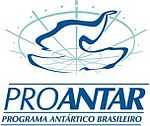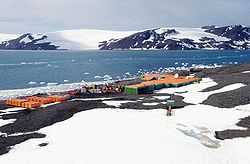Brazilian Antarctic Program
 | |
| Agency overview | |
|---|---|
| Formed | January, 1982 |
| Website | PROANTAR |
The Brazilian Antarctic Program (Portuguese: Programa Antártico Brasileiro; PROANTAR) is a program of the Brazilian Navy which has presence in the continent of Antarctica.[1] It coordinates research and the operational support for research in the region. It currently maintains a year-round research station in Antarctica (Comandante Ferraz Antarctic Station), as well as several seasonal field camps. It also maintains two research vessels that sail in the Antarctic waters (the icebreakers Almirante Maximiano and Ary Rongel).[1]
History
The program was officially created in January 1982, when the Brazilian Navy acquired the Danish icebreaker MV Thala Dan, later renamed Barão de Teffé. That same year, Brazil sent its first expedition ("Operation Antarctica I") to the Antarctic continent and the Barão de Teffé performed a reconnaissance mission to the northwestern sector of Antarctica in order to select the location where the future Brazilian base would be built. The success of that expedition resulted in international recognition of the Brazilian presence in Antarctica, which allowed the acceptance of the country as a consultative party to the Antarctic Treaty in 1983. A second expedition ("Operation Antarctica II") was held in the summer of 1983-84, with the main task of transporting and building the Brazilian station. The Comandante Ferraz Antarctic Station, consisting of 8 modules, was completed on 6 February 1984. The station was expanded to 33 modules in the following year. Starting in 1986, the station was permanently occupied during the 365 days of the year.[1]
In February 1991, President Fernando Collor de Mello reaffirmed Brazil's interest in the region by visiting the Brazilian Antarctic base, where he spent three days. He was the first Brazilian president to set foot in the Antarctic.[2] In January 2008, 13 congressmen members of the Brazilian Antarctica Parliamentary Committee visited the Brazilian Antarctic base.[3] Another visit by the members of Congress took place in January 2009.[4]

On February 16, 2008, President Luiz Inácio Lula da Silva and a delegation of twenty-three people, including first lady Marisa Letícia, visited country's base in Antarctica. The Brazilian Government defined the presidential trip as a "political gesture" in support of the work displayed by Brazilian scientists and military personnel.[5][6]
In 2009, the Brazilian Navy incorporated the icebreaker Almirante Maximiano (ex-"Ocean Empress") into its fleet. The Almirante Maximiano operates UH-12/13 and IH-6B aircraft with a hangar for two helicopters. The Brazilian Navy installed five modern laboratories for the development of scientific research in the Antarctic environment. The ship can accommodate 106 passengers, with 1/3 being scientists and researchers.[1]
In 2009 Brazil made its first national scientific expedition to the Antarctic ice sheet.[7][8] The expedition integrated atmospheric, glaciological, geological and geophysical studies along the Patriot Hills area and also along the subglacial lake Ellsworth area.[7] On 12 January 2012, the Brazilian Antarctic Program inaugurated the Criosfera 1 module, located in Union Glacier, on the plateau of the western Antarctica ice sheet, at 84°00' S–79°30' W. It is located 670 kilometres (420 mi) from the geographical South Pole and 2,500 kilometres (1,600 mi) south of the Comandante Ferraz Brazilian Antarctic Base.
On 25 February 2012, a blast in the machine room housing the generators at the station caused a fire that, according to the Brazilian navy, destroyed approximately 70% of the building.[9] Two soldiers, originally reported as missing by the Brazilian navy, were found dead in the debris of the station after the fire, while a third one sustained non-life-threatening injuries.[10] The Brazilian government estimates that it will take about two years to rebuild the base.[11]
Facilities
In Antarctica

- Comandante Ferraz Antarctic Station (UN/LOCODE: AQ-CFZ), a year-round station located in Admiralty Bay, King George Island, at 62°08′S 58°40′W / 62.133°S 58.667°W[1]
- Criosfera 1, a standalone module located in Union Glacier, at 84°00′S 79°30′W / 84.000°S 79.500°W[12]
- Refuge Emílio Goeldi, a shelter located at Elephant Island, at 61°05′S 55°20′W / 61.083°S 55.333°W[13]
- Refuge Astronomer Cruls, a shelter located at Nelson Island, King George Island, at 62°14′S 58°48′W / 62.233°S 58.800°W[13]
- Refuge Engineer Wiltgen, a shelter located at Elephant Island, at 61°01′S 55°21′W / 61.017°S 55.350°W[13] (dismantled)
- Refuge Pe. Balduino Rambo, a shelter located at Fildes Peninsula, King George Island, at 62°12′S 58°59′W / 62.200°S 58.983°W[13] (dismantled)
- Hardy Point Camp, a camp located on Greenwich Island, at 62°30′S 59°45′W / 62.500°S 59.750°W[13]
- Harmony Point Camp, a camp located on Nelson Island (South Shetland Islands), at 62°18′S 59°14′W / 62.300°S 59.233°W[13] (Dismantled)
Outside Antarctica
- Estação de Apoio Antártico - Support station located at Rio Grande
Transport
The Brazilian Navy and the Brazilian Air Force are responsible for the logistics of the Brazilian Antarctic Program, including the transport of military and civilian personnel, equipment, and supplies to Antarctica. The main equipment used for this purpose are:[1]
Ships
.jpg)
- Almirante Maximiano (H-41) - Icebreaker and oceanographic research ship of the Brazilian Navy.
- Ary Rongel (H-44) - Icebreaker and oceanographic research ship of the Brazilian Navy.
- Cruzeiro do Sul (H-38) - Oceanographic research ship of the Brazilian Navy.
- Barão de Teffé (H-42) - Oceanographic research ship of the Brazilian Navy (decommissioned).
- NOc Almirante Câmara (H-41) - Oceanographic research ship of the Brazilian Navy (decommissioned).
- NOc Almirante Álvaro Alberto (H-43) - Oceanographic research ship of the Brazilian Navy (decommissioned).
- NOc Professor Besnard - Oceanographic research ship of University of São Paulo.
Aircraft
- Bell JetRanger (IH-6B) - Helicopters which operate on the Almirante Maximiano.
- HB350 Esquilo (UH-12/13) - Helicopters which operate on the Ary Rongel.
- C-130 Hercules - Military transport aircraft of the Brazilian Air Force.
Organizations
The Brazilian Antarctic Program is managed by the Brazilian Navy in partnership with various government organizations.[1] Also, several Federal universities and research institutes take part in the program.
- Ministry of Defense, manages and operates the Brazilian Antarctic Program through the Brazilian Navy and Brazilian Air Force;
- National Council for Scientific and Technological Development (CNPq), funds the coordination and implementation of research;
- Ministry of Science and Technology, sets the scientific research policy;
- Ministry of the Environment, ensures compliance with international rules to minimize the impact of human presence in Antarctica;
- Ministry of Foreign Affairs, responsible for the National Policy of Antarctic Affairs;
- Ministry of Mines and Energy (through Petrobras), supplies the special antifreeze fuel for the facilities and vehicles operating in Antarctica.
References
- ↑ 1.0 1.1 1.2 1.3 1.4 1.5 1.6 Programa Antartico Brasileiro ("Brazilian Antarctic Program) Brazilian Navy. Retrieved on 2012-02-27. (Portuguese).
- ↑ Brazil Warms to Job of Exploring the Frozen Continent Antarctica: President Collor pays a visit, pointing up the country's interest in the bottom of the world Los Angeles Times. Retrieved on 2009-07-15.
- ↑ Parlamentares que visitaram a Antártida já estão no Brasil. Chamber of Deputies of Brazil. Retrieved on 2009-07-15. (Portuguese)
- ↑ Deputados visitam Antártida para conhecer pesquisas na região Chamber of Deputies of Brazil. Retrieved on 2009-07-15. (Portuguese)
- ↑ President Lula da Silva visits Brazilian base in Antarctica MercoPress. Retrieved on 2009-07-15.
- ↑ Lula Visits a Piece of Brazil in Antarctica and Gets Emotional Brazzil Magazine. Retrieved on 2009-07-15.
- ↑ 7.0 7.1 Brazil: 2009/2010 Annual Information (Brazilian National Multidisciplinary Expedition to the Antarctic Ice Sheet: investigating the cryospheric response to global changes) Antarctic Treaty System. Retrieved on 2010-10-23.
- ↑ Brasil instalará puesto avanzado en interior de la Antártida Fundación Nuestro Mar. Retrieved on 2010-10-23. {{{2}}}.
- ↑ Two die in fire at Brazil's Antarctic research station BBC. Retrieved 26 February 2012.
- ↑ (Portuguese) Base da Marinha na Antártida será reconstruída em 2 anos, diz Amorim ("Navy base in Antarctica will be rebuilt in 2 years, says Amorim") G1. Retrieved 26 February 2012.
- ↑ Criosfera 1 - a landmark achievement Adventure Network International. Retrieved on 2012-02-27.
- ↑ 13.0 13.1 13.2 13.3 13.4 13.5 WABA Directory: Brazil DDXC. Retrieved on 2012-02-27.
External links
- (Portuguese) Programa Antártico Brasilero ("Brazilian Antarctic Program") Official website, Brazilian Navy
- (Portuguese) Programa Antártico Brasileiro ("Brazilian Antarctic Program") National Council for Scientific and Technological Development - CNPq
- (Portuguese) Projeto de Meteorologia Antártica ("Antarctica Meteorologic Project") National Institute for Space Research - INPE
- (Portuguese) Frente Parlamentar de Apoio ao Programa Antártico Brasileiro ("Parliamentary Front in Support of the Brazilian Antarctic Programme") Senate of Brazil